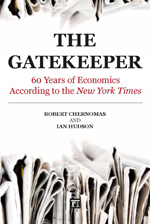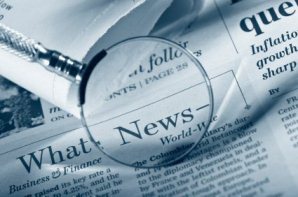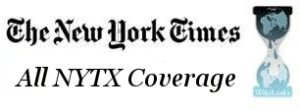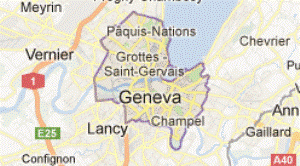BOOKS » STRUCTURAL ANALYSIS
The Gatekeeper: 60 Years of Economics According to The New York Times
January 25, 2012 · 1 Comments

A book excerpt from The Gatekeeper: 60 Years of Economics According to The New York Times by Robert Chernomas and Ian Hudson, Paradigm Publishers, 2011.
The New York Times is arguably the most influential newspaper in America (some might say the world) and has been so for decades. It is the largest metropolitan newspaper in the country and one of only a very few papers, including the Wall Street Journal, Chicago Tribune, and Washington Post, that can claim a truly national reach. A half century ago a member of the State Department acknowledged the importance of the Times, claiming, “The first thing we do is read the newspaper—the New York Times.”i More recently, a 2009 article in Vanity Fair described the Times as “the flagship of serious newspaper journalism in America.”ii Its columnists have become public personalities, sought-after figures on the punditry circuit, dispensing wisdom on issues of political and economic import. Times’ staff has won far more Pulitzer Prizes than any other paper. According to media analyst Jack Lule, “more than any other U.S. news medium, the New York Times has become crucial reading for those interested in the news, national politics, and international affairs.… Though not the biggest, it may well be the most significant newspaper in the world.”iii
Publisher Arthur Sulzberger Jr. claimed that if the Times has any ideology, it is “urbane,” by which he means big-city and broad-minded. It provides an account of the world rich in eloquent prose, sophistication, depth, and, within certain limits, balanced content. The Times’ writing is in the long tradition of the Enlightenment, where reason is the primary basis of authority as opposed to irrationality, superstition, and tyranny. It fosters modernism, discriminating taste, and a cosmopolitan outlook as a result of educated editors and correspondents catering to a civilized, cultivated, and cultured readership. The Times provides its readers with answers from writers who have paid attention to the facts and arguments and who have a professional commitment to providing answers. The Times’ modernism, with its belief in science and social progress, provides its readers with a bulwark against the superstition and intolerance represented by media outlets like Fox News and their viewers. The Times is a place to feel a sense of community with those who are above a media that panders to the lowest common denominator.
From the right, well-known conservative pundits like Ann Coulter and Bill O’Reilly frequently pillory the Times for its left-leaning views, despite editor Arthur Sulzberger’s repeated insistence that his paper is not liberal.iv In an interview with the New York Observer, Coulter claimed, “My only regret with (Oklahoma City bomber) Timothy McVeigh is he did not go to the New York Times Building.”v According to O’Reilly, “Somewhere along the line, the Times got out of the news business and into the nation-building business. Its primary intent is no longer to provide objective information and fair-minded analysis to its readers, but to convince them to support a brave new world in the United States. The power of the Times is being used to promote the formation of a new America, a bright, shining progressive city on a hill of steep government entitlements.… In almost every section the reader is confronted with liberal ideology.”vi
A website, TimesWatch.com, is dedicated solely to “documenting and exposing the liberal political agenda of the New York Times.” In a more literary vein, in Journalistic Fraud: How the NYT Distorts the News and Why it Can No Longer Be Trusted, Bob Kohn argued that the Times furthers a leftist agenda by presenting ideology as fact. The Cato Institute, whose mission “seeks to broaden the parameters of public policy debate to allow consideration of the traditional American principles of limited government, individual liberty, free markets, and peace,” has often featured writers critical of the Times. Alan Reynolds accused the paper of “escalating … rhetoric to authentic class warfare” for pointing out that workers were not doing particularly well in the economic recovery of the early 2000s.vii
It is important to note that much of the criticism of the Times’ “left-wing” slant is based on the paper’s “cultural” perspective on, for example, women’s and gay rights or the separation of church and state. The Times’ writing in these areas might well reveal a consistent liberal perspective—maddening those opposed to social progress as much as it would be supported by the Times’ urbane readership—but of little concern to corporate America. This book is about that which is central to corporate needs—economic policy.
From the left, numerous writers argue that the Times may be more liberal than some other media outlets, but that as a part of the “mainstream” media, it will inevitably contain a conservative bias. As the title of his book Lapdogs: How the Press Rolled Over for Bush suggests, Eric Boehlert claims that the mainstream media gave the Bush-Cheney presidential ticket a remarkably easy ride. According to Boehlert, during Bush’s first term, the Times was guilty of deliberately killing stories that would have embarrassed the Bush administration and presenting other issues so that they placed the administration in a favorable light.viii
Perhaps the most famous media critic on the left, Noam Chomsky, argues that as a privately owned corporation, dependent on advertising revenue, the Times has little choice but to have a pro-business bias. This is true in its stance on foreign policy in areas like Vietnam and Nicaragua and also in domestic economic issues like taxes on business.ix Chomsky argued that the “so-called liberal” Times offered complete support for the North American Free Trade Agreement. The Times’ articles that were not directly supportive of NAFTA belittled opponents’ ideas, including “tremendous labor-bashing.”x Similarly, in the late 1970s the Times took a “mildly supportive” stance on a tax bill that was opposed by New York businesses. Attributing a small decline in advertising and stock values to its position on the tax bill, the Times “shifted its entire editorial staff,” purging it of liberals including John Oakes.xi
Authors from one ideological perspective are convinced that the Times is pushing a dangerously liberal, left-wing agenda on its readers, while authors of the opposite stripe claim that it is conservative. Is it possible that both claims are correct? What we are attempting to do in this book is to disentangle the myth from the fact that surrounds so much of the debate on the Times.
Our Bias
This book will argue that the usual liberal-conservative dichotomy that has been used as the previous spectrum of media bias, while accurate, overlooks a more profound bias. Casting the debate in such a narrow fashion is, in fact, very misleading because the liberal/conservative or Democrat/Republican spectrum is remarkably limited. An economic debate that limits itself to options pursued by these two camps would be similarly limited. It is also misleading because it omits the real bias of the Times, which is that it supports the long-term interests of U.S. business involving both liberal and conservative policies.
Our claim that the economic debate in the Times is narrower than most academic analysts have understood is, in some ways, mirrored by Daniel Hallin’s analysis of the Vietnam War.xii He argued that most of the research surrounding the media’s role in the war focused on whether it was “antagonistic” or “supportive.” The conventional conclusion was that an uncensored media was in opposition to the U.S. government and its role in Vietnam and contributed significantly to the dissatisfaction with the war in America that caused its eventual withdrawal. Hallin claimed that the actual truth is much more nuanced. “Structurally the American news media are both highly autonomous from direct political control and through the routines of the news gathering process, deeply intertwined in the actual operation of government. Culturally and ideologically, they combine the Progressive suspicion of power with a respect for order, institutions, and authority exercised within those institutions that is equally part of twentieth century liberalism.”xiii
Hallin argued that the media was often very supportive of the war, in part because journalistic conventions, like reliance on official sources, set bounds on the range of issues that could be seriously discussed. When the Times reported on the Gulf of Tonkin incident it did so by documenting quotable facts from official government sources. The fact that the government was deliberately and systematically lying in order to create a justification for entering the war made “the New York Times essentially an instrument of the state.”xiv The media in general was largely supportive of the entire Vietnam effort prior to the Tet Offensive.xv
As the war claimed more U.S. lives and the conflict became increasingly intractable, the media did become more critical, but Hallin claims that there were important boundaries on the criticism. While the media became a battleground between different political factions about the war, “it was a conflict over tactics not principles.”xvi According to Hallin, some sections of the American public, like college students, were questioning the assumptions about the role of American foreign policy, not merely the management of the war. These critics challenged the benevolence of American power and saw the “intervention” as an “aggressive war motivated by power, comparable to the Soviet intervention in Czechoslovakia,” but issues of this sort were simply not on the news agenda. “Never, for example, did I hear an American utter the word imperialism on television.”xvii Even in periods of crisis, when the media distance themselves from incumbent officials and their policies, “they do not make the system—or its core beliefs—an issue.”xviii
We are making a very similar tactics-versus-core-beliefs claim about economic policy in this book. The tactics of how best to support U.S. business using liberal or conservative policy is an acceptable ground for debate and the Times is a crucial venue in which that can happen. The core belief of the system, whether supporting business has unacceptable costs for the rest of society, is not a common topic of discussion.
The perspective by which we analyze both the actual, real-world economy and how that is reflected in the Times is through its effects on different groups in the economic system. Economic conditions and policies have important distributional effects that fall unevenly on different groups. Society can be broadly divided into two groups: those who control businesses, and all those whom Alan Budd, professor of economics at the London Business School and chief economic advisor to Margaret Thatcher, refers to as the “working classes”; that Lester Thurow, professor of economics at MIT and former dean of the MIT Sloan School of Management, identifies as “nonsupervisory workers”; that Alan Greenspan’ characterizes as “traumatized workers”; and that Thomas Piketty and Emmanuel Saez refer to as the bottom 90 percent of American taxpayers.
These “workers” and their families make up the vast majority of the population of the United States. We use two benchmarks in our analysis. One is how these “workers” have fared in comparison to the business class with respect to wages and productivity, profits, wealth, and income distribution. The second benchmark is to compare the economies of different countries (e.g. Sweden and the United States) with respect to indicators—like wages, hours of work, pensions, health indicators, and work safety—that matter to the vast majority of the population. In other words, what are the class effects of different policy options? There is often an implied assumption that liberal Democratic policies would favor the “workers” and conservative Republican polices would benefit businesses and their owners. However, this is not a particularly accurate assumption. While conservative policies rarely benefit the “workers,” liberal policies can improve business profits, especially in the long run, often without improving conditions for workers and the citizenry at large.
Identifying the Bias of the Times
The ability of the media to shape stories and issues has long been recognized. The press became known as the Fourth Estate precisely to acknowledge that while the first three estates (nobility; clergy; and commoners, which in those days meant the middle class with property) had a formal voice in democracy, the press was the institution most able to advocate for and frame political issues. Over time, those discontented with what they saw to be the cozy role of the mainstream press in supporting the status quo coined the term the Fifth Estate to describe forms of media that challenged the powers that be. In this context we will demonstrate how the Times can be seen as the preeminent example of the Fourth Estate, using its prestige and formidable skills to advocate for the U.S. capitalist class as a whole by helping to frame political issues.
Journalists have a code of ethics, and we would expect those at the Times to be among the most committed to the highest standards in the industry. This code stipulates that competing points of view should be balanced and fairly characterized. The subjects of adverse news stories should be allowed a reasonable opportunity to respond before the story is published or broadcast. Reporters must test the accuracy of information from all sources and exercise care to avoid inadvertent error. Stories should never misrepresent the ideas of their subjects, nor should they present information out of context. Further, analysis and commentary should be labeled and not misrepresent fact or context. It is this final stipulation that creates the famous insistence that opinion pieces like editorials and op-eds must be kept completely separate from reporting on news pieces, including keeping distinctly different staffs for the two sections.
While these criteria are designed to create an objective press, editors, writers, and owners still have considerable latitude in their role reporting the news. They must decide which stories to follow and which to ignore. Once a story is selected there are a number of different angles or perspectives in which it could be framed. All this creates an environment where, while still upholding a code of ethics, there is still tremendous discretion in what is reported and how it is covered. So, there is the opportunity for bias in the media, and we have shown above in the discussion of the economics of the New York Times, that the motive for bias is also present. Our hypothesis is that it is not only the more explicitly opinion or commentary sections of the Times that will contain bias, but that it will also be present in its news stories. In order to explicitly test for this, the opinion pieces will be separated from the news stories in all of the issues to be examined.
We hypothesize that given the particular economic opportunities and constraints that allow the Times to play its crucial liberal and conservative gatekeeper role, a critical reader should look for some specific patterns in the Times’ reporting. These patterns help the Times frame issues to legitimize corporate ownership in the economy while criticizing specific firms or policies that might threaten profitability and legitimacy in the long run. First, does the Times have a consistent predisposition in its reporting on issues that constrain corporate profitability, especially those that might call into question the legitimacy of corporate power and the policies necessary to sustain it? We would predict that the Times would attempt to frame these policies and their agents in a negative light and brand them so that readers know this is someone or something not to be trusted. Conversely, it is also likely to cast supportive policies, and the people or institutions that champion them, more positively.
Second, does the Times tend to assume that firms and the policies that support them are innocent until proven guilty? While this is a commendable practice in the court of law, it stands in the way of the Times detecting any consistent problems with corporate behavior or even being sufficiently inquisitive when problems emerge as a result of the corporate system. This “malfeasant amnesia” means that the Times will not generally extrapolate from the past on matters that might threaten corporate interests in general.
Third, as we have insisted, amnesia does not mean that the Times will side with all firms at all times. On the contrary, when evidence does mount about cases of corporate misbehavior, the Times would be highly critical of individual members or sections of the business community, since their misdeeds threaten the profitability and legitimacy of the larger corporate world. However, when reporting on these stories the Times should ensure that the problems are a result of “bad apples” that are violating the normal code of good business conduct and not a result of systemic flaws.
Finally, timing is important in the media. The Times is most influential when it reports on information from which lessons can be drawn for current policy issues. When incontrovertible evidence makes it impossible for the Times to credibly avoid criticizing issues or people that run counter to the long term interests of corporate America, these concessions to the truth can be made belatedly, when they can have less impact on the current policy debate.
The Times is not a lapdog of corporate America. Nor is it a raving apostle of liberal social engineers. Rather, it is both.
The Times is first among the media gatekeepers in support of corporate ideology. It distills an acceptable line for capital to take on a particular issue, produces corporate ideology, and disseminates it to the public. In order to effectively play this role, it defines acceptable corporate and government behavior. It is critical of actions that threaten the accumulation of profits for the system or undermine the political legitimization on which it depends. It imposes discipline for the business class as a whole. The Times almost behaves like a responsible parent when U.S. business acts in a childish manner by punishing any self-destructive behavior that will jeopardize long-term growth. The Times’ long-term profitability depends on its willingness to be critical of corporate and conservative state activity in prescribed historically specific ways. This makes the Times both a bulwark against reaction and a fetter on further progress against exploitation, imperialism, environmental destruction, injustice, and inequality.
i Cohen, B. cThe Press and Foreign Policy, (Princeton, NJ: Princeton University Press, 1963), pp 164–165.
ii Bowden, M. “The Inheritance,” Vanity Fair, May, 2009, pp 128–135.
iii Lule, J. Daily News, Eternal Stories: The Mythological Role of Journalism, (New York and London: The Guilford Press, 2001), p 6.
iv Bianco, A. “The Future of the New York Times,” Business Week, January 17, 2005.
v Gurley, G. “Coultergeist,” New York Observer, August 21, 2002.
vi O’Reilly, B. “The Worst of Times,” New York Daily News, June 21, 2004, Available at http://www.nydailynews.com/news/ideas_opinions/story/204738p-176737c.html, Accessed March 28, 2008.
vii Reynolds, A. “Classless Warfare Escalates,” 2004, Available at http://www.cato.org/pub_display.php?pub_id=2486, Accessed January 5, 2008.
viii Boehlert, E. Lapdogs: How the Press Rolled Over for Bush, (New York: Free Press, 2006).
ix Chomsky, N. Understanding Power: The Indispensable Chomsky, (New York: The New Press, 2002), pp 21, 23.
x Chomsky, N. “The Big Idea with Andrew Marr—Interview with Noam Chomsky,” 1996, BBC, Available at http://www.zmag.org/Chomsky/interviews/9602-big-idea.html, Accessed March 20, 2008.
xi Chomsky, Understanding Power, p 23.
xii Hallin, D. The Uncensored War: The Media and Vietnam, (New York: Oxford University Press, 1986).
xiii Ibid, p 8.
xiv Ibid, p 70–71.
xv Ibid, p 9.
xvi Ibid, p 28.
xvii Ibid, p 208.
xviii Ibid, p 208.
By admin
Readers Comments (1)
Sorry, comments are closed on this post.










Looking forward to reading The Gatekeeper. I’ll save Front Page Economics by Gerald D. Suttles to read in tandem with it.
Best regards